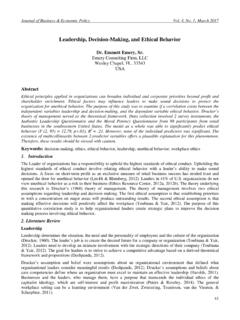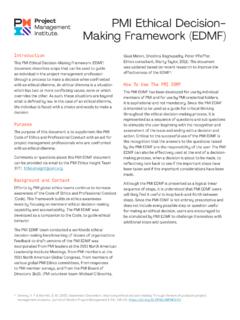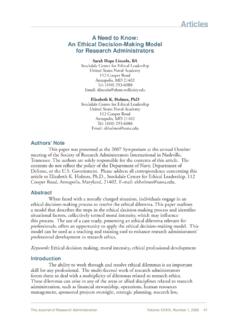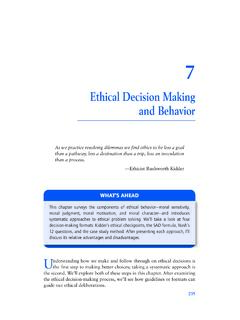Transcription of Seven Step Guide to Ethical Decision Making - Dawn Wright
1 Seven Step Guide to Ethical Decision Making 1 State Problem For example, there's something about this Decision that makes me uncomfortable or do I have a conflict of interest? . Verify issues and clarify problem. Also, many 2. Check Facts problems disappear upon closer examination of situation, while others change radically. 3 Identify relevant factors For example, persons involved, laws, professional code, other practical constraints. 4. Be imaginative, try to avoid dilemma ; not Develop list of yes or no but whom to go to, what to options say. Use such tests as the following: Harm test: does this option do less harm than alternatives? Publicity test: would I want my choice of this option published in the newspaper?
2 Defensibility test: could I. defend choice of option before Congressional committee or 5 Test options committee of peers? Reversibility test: would I still think choice of this option good if I were adversely affected by it? Colleague test: what do my colleagues say when I describe my problem and suggest this option as my solution? Professional test: what might my profession's governing body or ethics committee say about this option? Organization test: what does the company's ethics officer or legal counsel say about this? 6 Make a choice based on steps 1-5. What could you do to make it less likely that you would have to make such a Decision again? Are there any precautions can you take 7.
3 As individual (announce your policy on question, change job, etc.)? Review steps 1-6 Is there any way to have more support next time? Is there any way to change the organization (for example, suggest policy change at next departmental meeting)? DESCRIPTION. Based on Davis 1999, drawn following Table 1, DiBiase et al 2009. F. Harvey 6/2010. GISP rofessional Ethics Project Case study: Tidal Wetland Mapping Kelly is a GIS analyst and owner of a small environmental consulting firm that specializes in wetlands assessment and mapping. In addition to her GIS skills, she is a trained botanist with years of experience doing field surveys and analyzing soil samples to delineate tidal wetlands.
4 She has recently begun work on a project commissioned by the State of Oregon to identify estuarine areas on the Pacific coast and to prioritize them for conservation and restoration. The contract is a great opportunity for Kelly's firm. If her work is well received, it could lead to similar and even more lucrative contracts in Oregon and elsewhere. The contract requires Kelly and her team to follow the client agency's established protocol for mapping tidal wetlands. The protocol involves several existing data sources. One is a digital map of probable tidal wetlands in the area (Scranton 2004). The protocol allows removal of polygons from this dataset if aerial photography interpretation, field visits and other ancillary data suggest these do not represent actual tidal wetlands.
5 In addition, areas may be added to the tidal wetlands dataset after field inspection if these areas are already identified and mapped in the National Wetlands Inventory (NWI) database. However, because the protocol is designed to be repeatable and usable by many people who may not have a background in wetland delineation, it does not include methods for adding new wetlands to the database that aren't already mapped in the NWI. During Kelly's visits to sites of previously identified tidal wetlands, she finds evidence of additional wetlands that aren't mapped in either data source. However, the client agency's protocol doesn't accommodate the soil sampling needed to confirm Kelly's hypothesis.
6 Neither does her project budget and schedule of deliverables provide the money or time needed to perform the extra work. She knows she cannot devote unbillable hours to the tasks either, since the project budget is barely adequate for the scope of work. There seems to be no way to verify with certainty that these areas are or are not wetlands. Leaving the sites out of her map products could result in important estuarine resources being excluded from conservation and restoration plans. It may even reduce the overall efficacy of the agency's wetland conservation program by leaving out ecologically and spatially important linkages between previously mapped wetlands. But including them would violate the methodology of the protocol and could threaten the perceived integrity of her work.
7 It would also cause her firm to lose money, which a small company cannot afford to do. What should Kelly do? References Scranton, R. (2004). The application of Geographic Information Systems for delineation and classification of tidal wetlands for resource management of Oregon's coastal watersheds. Thesis, Marine Resources Management Program, Oregon State University, Corvallis. Fish and Wildlife Service. National Wetlands Inventory. Retrieved March 6, 2009 from 10-Apr-10 1. Resources for educators Suggested discussion points, relevant GISCI Rules of Conduct, and further resources related to this case study are available on request. Send request to David DiBiase along with contact information (including your position and affiliation) and a brief description of how you plan to use the case.
8 Suggested citation: Duncan, James (2009) Case Study: Public Access to Government Data. GISP rofessional Ethics Project Reviewers: Dawn Wright (Department of Geosciences, Oregon State University), David DiBiase (Dutton e-Education Institute, Penn State University), Francis Harvey (Department of Geography, University of Minnesota). Acknowledgment Acknowledgment: This case was developed as part of the course, GEO 599, Responsible GIS Practice: Ethics for Future Geospatial Professionals at Oregon State University, Winter 2009, under the guidance of Professor Dawn Wright . The author thanks Laura Brophy, owner of Green Point Consulting, LLC, for her suggestions and time in developing this case study.
9 This work was supported by National Science Foundation (NSF) grant # GEO-0734888. Any opinions, findings and conclusions or recommendations expressed in this material are those of the author(s) and do not necessarily reflect the views of the NSF. Terms of use Authors license this work under the Creative Commons Attribution-Noncommercial-Share Alike Unported License. To view a copy of this license, visit or send a letter to Creative Commons, 171. Second Street, Suite 300, San Francisco, California, 94105, USA. 10-Apr-10 2. GISP rofessional Ethics Project Case study: Tidal Wetland Mapping Resources for educators Suggested discussion points 1. Identify and discuss elements of the ASPRS Code of Ethics and GISCI Code of Ethics and Rules of Conduct that pertain to this case.
10 2. Are there alternative methods the GIS Professional can use to achieve both goals? If so, what are they? 3. Should this type of resource mapping be done if it can't be done to the fullest accuracy possible? 4. Who is or should be responsible for Making sure these map products are used appropriately? Relevant Elements of the GISCI Code of Ethics I. Obligations to Society: 1. Do the Best Work Possible. Be objective, use due care, and make full use of education and skills. I. Obligations to Society: 1. Do the Best Work Possible. Practice integrity and not be unduly swayed by the demands of others. II. Obligations to Employers and Funders: 1. Deliver Quality Work. Define alternative strategies to reach employer/funder goals, if Relevant GISCI Rules of Conduct I.











